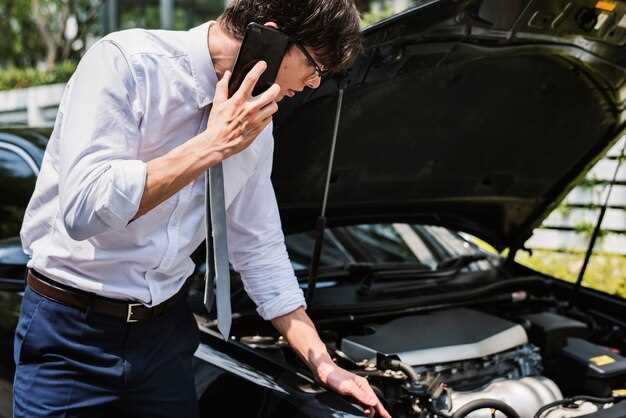How to identify engine overheating symptoms

Overheating is one of the most common issues that can affect an engine, leading to significant damage if not addressed promptly. A well-functioning cooling system is essential for maintaining the optimal temperature of your vehicle’s engine. When this system encounters problems, it can result in severe consequences for the engine’s performance and longevity.
Understanding the symptoms of engine overheating is crucial for every driver. Early detection can prevent costly repairs and ensure the safety of your vehicle. Symptoms can manifest in various ways, including unusual sounds, dashboard warnings, and changes in performance. By recognizing these signs, you can take immediate action to protect your engine and its surrounding components.
In this article, we will delve into the specific indicators of overheating and provide practical tips on how to spot them before they escalate into major issues. Awareness of your engine’s conditions can empower you to maintain a healthy cooling system, ultimately leading to a more reliable driving experience.
Identifying Warning Signs of Overheating in Your Car
Recognizing the symptoms of engine overheating is crucial for maintaining your vehicle’s performance and longevity. Several warning signs can indicate that your car’s engine is experiencing overheating issues.
1. Temperature Gauge Rising: The most direct way to identify engine overheating is by monitoring the temperature gauge on your dashboard. If it approaches the red zone or exceeds normal levels, this is a strong indication that your cooling system may be failing.
2. Warning Lights: Many modern vehicles are equipped with warning lights that alert you when the engine temperature is too high. If you see a warning light, it is essential to pull over as soon as safely possible to prevent further damage.
3. Steam from the Engine: One of the most visible signs of overheating is steam billowing from under the hood. This occurs when coolant is boiling or escaping from the cooling system, indicating a severe issue requiring immediate attention.
4. Unusual Noises: Overheating engines can produce strange noises, such as knocking or hissing sounds. These noises often result from metal components expanding or coolant boiling, signaling a serious problem.
5. Diminished Performance: If you notice a loss of power or a decline in acceleration, overheating could be the culprit. An engine struggling to operate efficiently may indicate that it is running hotter than it should be.
6. Coolant Leaks: Puddles of coolant under your vehicle or a noticeable decrease in coolant levels are significant indicators of potential overheating. A leak in the cooling system can cause insufficient coolant flow, leading to engine overheating.
7. Burning Smell: An unusual burning odor often signals that the engine is overheating. This smell might come from the coolant or other fluids being burned due to excessive heat.
Being aware of these warning signs can help you act swiftly, potentially saving your engine from severe damage. If you experience any of these symptoms, it is crucial to check your vehicle’s cooling system and consult a professional mechanic to address any overheating issues before they escalate.
Common Causes of Engine Overheating and Their Symptoms

Engine overheating can be detrimental to your vehicle’s performance and longevity. Recognizing the common causes is essential for effective troubleshooting and prevention. Below are some primary causes of overheating and their accompanying symptoms.
1. Low Coolant Levels: The cooling system relies heavily on the right amount of coolant to regulate engine temperature. If coolant levels drop due to leaks or evaporation, the engine may overheat. Symptoms include the temperature gauge rising above normal and steam emanating from the engine compartment.
2. Faulty Thermostat: A malfunctioning thermostat can either stay closed, preventing coolant flow, or remain open, allowing coolant to circulate continuously without regulating temperature. Indicators of this issue include fluctuating temperature readings and poor engine performance.
3. Broken Water Pump: The water pump circulates coolant throughout the engine. If it fails, coolant cannot flow properly, leading to overheating. Symptoms may consist of unusual noises from the engine, low coolant levels, and a consistently high temperature gauge.
4. Clogged Radiator: A blocked radiator can hinder the cooling system’s ability to dissipate heat. This usually results from debris or sediment buildup. Signs of a clogged radiator include overheating during heavy use and an unusual odor from the engine area.
5. Leaking Hoses: Hoses that carry coolant can become brittle or cracked over time, leading to leaks. If you notice puddles under your vehicle or a visible drop in coolant levels, your engine may be at risk of overheating. Symptoms include the temperature gauge rising quickly and engine misfires due to overheating.
6. Malfunctioning Cooling Fans: Cooling fans help regulate engine temperature by drawing air through the radiator. If the fans fail to operate, the engine may overheat, especially in stop-and-go traffic. You may notice an increase in engine temperature and the fans failing to engage when needed.
7. Head Gasket Failure: A blown head gasket can cause coolant to mix with engine oil, leading to overheating and severe engine damage. Symptoms include white smoke from the exhaust, a sweet smell from the engine, and visible coolant loss without an obvious leak.
Knowing these potential causes and their symptoms will help you take timely action to prevent engine overheating and maintain your vehicle’s health.
Steps to Take When You Notice Overheating Symptoms

When you detect symptoms of overheating in your engine, immediate action is crucial to prevent further damage. First, pull over to a safe location as soon as it is safe to do so. Continuing to drive with an overheating engine can lead to severe mechanical failure.
Once stopped, turn off the engine to allow it to cool down. This is vital, as the engine temperature may continue to rise if the vehicle is still running. Allow at least 15-30 minutes for the engine to cool, during which you can assess the situation.
After the engine has cooled, check the coolant level. Open the hood carefully, keeping your face away from any steam. If the coolant reservoir is low, adding coolant can help restore proper cooling. Be cautious; never open the radiator cap while the engine is hot, as it can cause burns from hot steam or coolant.
If your engine is still overheating after adding coolant, look for visible leaks or signs of damage. Inspect hoses and connections for any cracks or disconnections that may lead to coolant loss. If you find any leaks, it’s advisable to call for professional help.
Additionally, examine the cooling fans. They should activate when the engine reaches a certain temperature. If the fans are not working, this could be a critical issue affecting the engine cooling system. In such cases, seek professional assistance to diagnose and fix the problem.
Finally, monitor the temperature gauge on your dashboard during your next drive. If overheating symptoms reappear, do not ignore them. Persistent overheating can lead to irreparable engine damage, requiring costly repairs.




